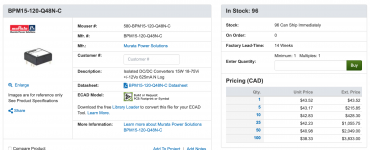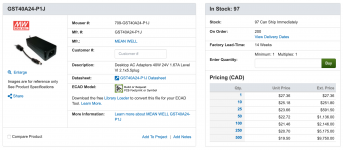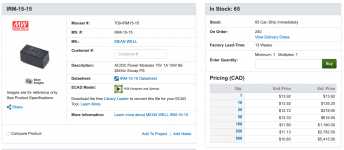Thanks for the info tom, when I looked into building my own passive volume control I found the Bill of Materials (BOM) was nearly £100.00 roughly as follows:
Good Alps pot £ 20 plus nice external volume control
Internals - Solid core silver or Litz wire £10 (1-meter min I could buy)
Cardas silver solder £25 ( would be enough for lots of units!)
Good Neutrik balanced XLR connectors (two inputs plus two outputs)£20.00
Nice wooden case with metal base and soft rubber feet. £ 25.00
There's no need for silver wire, silver solder, etc. Those items do a wonderful job of draining your wallet, but won't impact the flow of electrons in any meaningful way. Some may argue that silver is more conductive (7% more, if I recall correctly) than copper, but the silver wire used tends to be small gauge (to keep the cost under control). You could easily get lower resistance by using heavier gauge copper at a much lower cost.
There are very few cases where silver solder is required. You can read about those isolated cases here: Choosing Solder - Navigate the Different Alloys, Types of Flux, etc. – Neurochrome
I do agree that for simple items (such as a passive volume control), you can often buy a finished product for less than it would cost to make one yourself. However, as you also hint at, when you DIY things you have more control over what goes in the box. Thus, you can choose quality parts and 'geek out' with fancy wire and solder should you so choose.
In some cases - such as with many of my products - you can also build a higher performance product for less than the cost of a comparable commercial product (assuming such product is available). Take my Modulus-86, for example. You can build a stereo amp for around $400 if you're reasonably frugal with the chassis and power supply. The only commercial compete I'm aware of is the Benchmark AHB-2, which will set you back around $3k.
Tom
I have a question about power supply. How the PSU quality would affect the measurement?
Not by much. The power supply rejection ratio of the Universal Buffer is on the order of 120-130 dB, so I see no reason to go fancy on the supply. A power supply based on a pair of LM317/LM337 or LM7815/LM7915 voltage regulators would be perfectly fine.
I recommend using a regulated supply so the Buffer doesn't fry if your mains voltage is a little high one day.
Now the PSRR of the Universal Buffer does reduce at rate of ~20 dB/dec, so its PSRR at typical switching frequencies for SMPSes (50-100 kHz) will be lower than that for, say, 120 Hz rectifier hum. But the ripple voltage of most good SMPSes tends to be low and the switching frequency is outside the audible range anyway, so it will not impact the sound quality (by definition). Some care anyway. I care, because I prefer pretty graphs on my website. Those of us who care can either add a post-regulator following the SMPS or an LC filter. If you choose the latter, make sure to design the filter such that it doesn't degrade the output impedance of the supply, such that it provides meaningful attenuation of the switching frequency, and such that it does not degrade the noise of the SMPS.
I have several SMPS and regulated supplies, but they are probably not audiophile grade.
That's probably a good thing.
I get stellar results with the Mean Well brand of power supplies. Specifically, their IRM and MPM series are excellent for line-level products. They're not "audiophile grade" (ssh!!! don't tell them), but they perform really, really well.
Something tells me I should put together a Preamp Supply...
Tom
Something tells me I should put together a Preamp Supply...
…and if you can avoid mains that'd be a bonus! A preamp doesn't need too much power, you can use one of the many Isolated DC-DC converters, they're pretty cool. Murata, Recom, Traco, many to choose from. I'm looking at designing my own PSU similar to these by Oleg, time permits.
The DC/DC converters are pretty cool, but most are pretty low power. You're right, you don't need a lot of power in a preamp, but the Universal Buffer draws about 100 mA if you crank it to clipping. So a preamp with more than about three inputs is unlikely to run well from a DC/DC converter.
In a preamp supply, I'd just handle all the mains-related stuff for you. Just as I did in the SMPS-86.
Tom
In a preamp supply, I'd just handle all the mains-related stuff for you. Just as I did in the SMPS-86.
Tom
you probably haven’t searched this for a while, but there are lots of options 10W-25W: BPM15-120-Q48 ±12 ±625 or ±15 ±500 should be plenty/enough. The other I mentioned above have similar offeringsThe DC/DC converters are pretty cool, but most are pretty low power. You're right, you don't need a lot of power in a preamp, but the Universal Buffer draws about 100 mA if you crank it to clipping. So a preamp with more than about three inputs is unlikely to run well from a DC/DC converter.
you probably haven’t searched this for a while, but there are lots of options 10W-25W: BPM15-120-Q48 ±12 ±625 or ±15 ±500 should be plenty/enough. The other I mentioned above have similar offerings
That's possible. Last I looked was in September. The one you list is $40 (CAD). You need a wall wart to operate it. That's getting pretty expensive. Are you willing to pay that much to avoid having to solder an IEC inlet?
Let's say I want to build a preamp with multiple inputs and outputs, could we just use a source selector --> buffer --> volume --> buffer --> output selector scenario or this would compromise the setup?
If your inputs are either all differential or all single-ended, the source -> switch -> Buffer arrangement makes sense. If some are differential and others single-ended, I'd add a buffer for each differential input and switch on the single-ended side before going through the volume pot.
Tom
mmm I don't think that's a fair comparison, Tom. You might want to compare it against a SMPS86, maybe? It ain't free either…That's possible. Last I looked was in September. The one you list is $40 (CAD). You need a wall wart to operate it. That's getting pretty expensive. Are you willing to pay that much to avoid having to solder an IEC inlet?
That board is much bigger as well, and this can be a factor in a preamp, where we might want to have more than just a selector, volume and buffer. In the case we also have other boards (DAC, Phono, ...), you might also want to isolate their supplies, etc.
So, IMHO using isolated DC-DC is not something really weird in this scenario.
Also, it's not necessarily $40, a quick search returns REC15E-2412DZ and BPM15-120-Q48N-C for $30
You may be talking in USD vs the CAD I see on Mouser.
Here's a rough estimate for the total solution cost with the DC/DC converter you mention:
DC/DC Converter: $43.52
AC/DC switching supply: $27.36
TOTAL: $70.88
Here's the estimate for a solution based on the IRM-15-15 (mains input, 15 V output):
IRM-15-15: $13.92/each. Two are needed.
TOTAL: $27.84
So basically, you're willing to pay $43 CAD (= $33 USD) to avoid having to solder an IEC mains connector. I wonder how many would be willing to do that.
The supply I have in mind will be fancier than just two IRM switching bricks.
Tom
Attachments
I also gave two other reasons (size and isolation with other PSU's), but sometimes DIY can be none-sense 
Not trying to have an argument, (at all, I love your products, from which I own some), just putting more options on the table. You liked the SilentSwitcher options as well, and it's even more expensive than what i'm proposing.
Not trying to have an argument, (at all, I love your products, from which I own some), just putting more options on the table. You liked the SilentSwitcher options as well, and it's even more expensive than what i'm proposing.
I will be using the SilentSwitcher with the Universal Buffer (UB) in a special application (laboratory buffer/amp, SE-Bal and Bal-SE converter) where the only powered module is the UB. I need best possible performance and the ability to take it off the grid. Therefore the SilentSwitcher. Furthermore, I already have it so it free
I also gave two other reasons (size and isolation with other PSU's), but sometimes DIY can be none-sense
You'd get the same isolation with the IRM switching bricks.
Not trying to have an argument, (at all, I love your products, from which I own some), just putting more options on the table. You liked the SilentSwitcher options as well, and it's even more expensive than what i'm proposing.
I'm not trying to start an argument either. I'm sorry if I didn't "like" your solution to the same extent as the use of Jan's SilentSwitchers. There's a difference between "I'm going to use this other product" and "I think you should offer a product based on this...". In the former case, I look at whether the chosen solution is likely to break performance. In case of the SilentSwitcher, that's incredibly doubtful. In the latter case, I have to look at cost, market needs, etc.
I really do value your input. Thank you. It just so turns out that I've already looked at the solution you propose and decided against it due to cost.
Now there are other considerations in play here. Size is another one. The IRMs are pretty big. Add IEC inlet, output regulation, etc. and you're quickly at a 100x160 mm board size. That's definitely "large and in charge" for a preamp.
I'll keep thinking and maybe order some samples.
Tom
Tom, for what it is worth, for my purposes and in my situation, I don't really care how small something is or even how inexpensive it may be. I may be unusual, but I find the idea of making something small just because you can is abhorrent unless there are zero tradeoffs performance wise.
When you've had a chance to re-measure these buffers with say 12dB gain I'll make an order. The power supplies may even be interesting depending on where you end up with the design. An IR input selector board would be great...
Ians LiFePO4 battery power supplies would probably be nice as a power supply in a preamp with these buffers...there are a couple spare in the cupboard. Also, I have a high quality autoformer volume control here that would be worth trying out between your buffer and the amplifiers.
Anthony
When you've had a chance to re-measure these buffers with say 12dB gain I'll make an order. The power supplies may even be interesting depending on where you end up with the design. An IR input selector board would be great...
Ians LiFePO4 battery power supplies would probably be nice as a power supply in a preamp with these buffers...there are a couple spare in the cupboard. Also, I have a high quality autoformer volume control here that would be worth trying out between your buffer and the amplifiers.
Anthony
Tom, for what it is worth, for my purposes and in my situation, I don't really care how small something is or even how inexpensive it may be. I may be unusual, but I find the idea of making something small just because you can is abhorrent unless there are zero tradeoffs performance wise.
I agree with that. It's exceptionally rare that I optimize for only one variable.
I've found a DC/DC converter that happens to be incredibly tiny and able to supply plenty of power. It'll provide lower output ripple and noise than the Mean Well IRM-series. Also - and importantly - it switches at very high switching frequency (400-500 kHz), which makes effective post-filtering relatively easy to accomplish. The only drawback is cost ($35 USD).
OTOH, the small size would make it possible for me to offer the PCB for not that much money, so the total solution cost may end up being roughly the same as my original solution with the Mean Well IRM-series.
Tom
Tom, are there any tradeoffs regarding RFI/EMI with these switching power technologies? My 0.2mV cart/phono may appreciate lower emissions.
Not to my knowledge. I bet you get vastly more interference from your wifi network and cell phone. Many switchers are designed such that they can be used in the telecom industry. Thus, they tend to be significantly more quiet than a typical linear supply.
Tom
Tom:
Is it this combo of TDK-Lambda products you may be referring to?
DC/DC: CCG152415D TDK-Lambda | Mouser
AC/DC: KMS15A-12 TDK-Lambda | Mouser
Is it this combo of TDK-Lambda products you may be referring to?
DC/DC: CCG152415D TDK-Lambda | Mouser
AC/DC: KMS15A-12 TDK-Lambda | Mouser
RFI/EMI I don't know, but in DC/DC designer must handle Common Mode Output Noise, for sure. Have a look at section 5.3.2 Common Mode Output Filtering on DC/DC Book of Knowledge. Practical tips for the User PDF from Steve Roberts, M.Sc. B.Sc. Technical Director, RECOM
Last edited:
- Home
- Vendor's Bazaar
- Universal Buffer achieving -140 dBc (0.00001 %) THD


